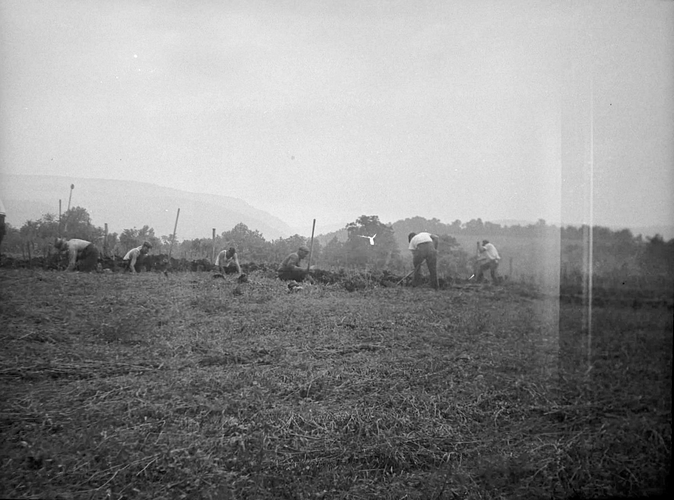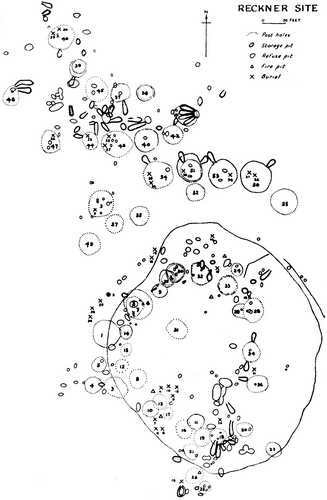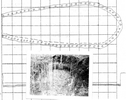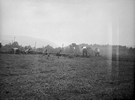Reckner
Overview
A WPA crew worked from May 27, 1937 to August 5, 1937 to expose the Reckner site (36 So 7). The site was was located on the western and northwestern sides of a slightly rounded knoll whose high elevation provided villagers with a commanding view of the surrounding hills and valleys. The Reckner site was divided into a palisaded circular village component that dated to ca. A.D. 1320 and several dwellings largely to the north of this palisaded component. The dwellings outside of the palisade are of unknown age but if all 58 dwellings at Reckner were occupied at the same time, the site's population would have reached around 461 villagers. More storage features were recorded at the Reckner site than at any other site within Somerset County. Several dwellings within and outside of the palisaded portion of the Reckner site had two or more of these storage features attached to their sides. Graves were located throughout the Reckner site, both within and outside the palisaded portion. A total of 36 definite and three possible graves were encountered at Reckner.

WPA field crew excavating at the Reckner site.
Site Map

Site map of Reckner produced by Edgar Augustine in 1942.
Site Scenes
All images date to 1937. Click image for larger version.

Pit 126, a hearth,
and its original plan
and profile from Reckner

Pit 59, a storage pit,
and its original plan
and profile from Reckner
References
Augustine, Edgar
1938 Recent Discoveries in Somerset County. Pennsylvania Archaeologist 8 (1):6-12.
Chassé, Kristen
2007 Monongahela Mortuary Practices at the Reckner Site. Journal of Middle Atlantic Archaeology 23:117-122.
Means, Bernard K.
1993 Monongahela Subsistence-Settlement Change: The Late Prehistoric Period in the Lower Upper Ohio Valley. Journal of World Prehistory 7:71-120.
1998 Archaeological Past and Present: Field Methodology from 1930s Relief Excavations in Somerset County, Pennsylvania and its Relevance to Modern Archaeological Interpretations. Journal of Middle Atlantic Archaeology 14:39-63. Available online.
1999 Monongahela Mortuary Practices in Somerset County, Pennsylvania: Observations and Implications. Pennsylvania Archaeologist 69 (2):15-44.
2002 Revisiting Mary Butler's "Three Archaeological Sites in Somerset County, Pennsylvania" for Continuing Insights into Depression-era Archaeology in Southwestern Pennsylvania and Late Prehistoric Monongahela Social Organization. Pennsylvania Archaeologist 72 (2): 8-46.
2003 Deliver Me From Mononga-Hell: Thinking Beyond the Culture History Paradigm to Examine the Temporal and Spatial Parameters of Somerset Monongahela Village Settlements. Journal of Middle Atlantic Archaeology 19:37-58.
2006 Circular Reasoning: Drawing on Models of Ring-shaped Village Spatial Layouts To Examine Villages in Late Prehistoric Pennsylvania. Unpublished Ph.D. dissertation, Department of Anthropology, Arizona State University, Tempe. University Microfilms, Ann Arbor.
2007 Circular Villages of the Monongahela Tradition. The University of Alabama Press, Tuscaloosa.

